Posted by: Northwest Eye in General on May 23, 2025
Overview
The article “10 Causes of Floaters in Eye You Should Know” highlights the various causes of floaters in vision, primarily linked to:
- Changes in the vitreous humor
- Aging
- Eye injuries
- Certain medical conditions
We understand that floaters can be concerning, and while they are often harmless, they can significantly impact your quality of life. Understanding their origins—such as the aging process or related eye diseases—can help alleviate worries and encourage proactive eye care. It’s common to feel anxious about changes in your vision, but knowing more about floaters can empower you to take the right steps for your eye health.
Introduction
In the intricate world of vision, eye floaters often emerge as a common yet perplexing phenomenon. We understand that this can be concerning for many, capturing the attention of both patients and eye care professionals alike. Described as small specks or threads that drift across one’s field of vision, floaters can indeed raise questions about eye health. It’s common to feel anxious, especially since they can indicate underlying changes in eye health.
The causes of floaters are diverse and complex, ranging from the natural aging process to the impacts of eye injuries and various diseases. As awareness grows, so does the importance of understanding these visual disturbances. This article delves into the multifaceted nature of floaters, exploring their causes and implications. We are here to help you through this process, emphasizing the vital role of regular eye exams in managing eye health effectively.
With expert insights and the latest research findings, readers will gain a comprehensive understanding of floaters and the proactive steps they can take to safeguard their vision. Remember, you are not alone in this journey, and we are committed to supporting you every step of the way.
Northwest Eye: Expert Insights on Floaters in Vision
At Northwest Eye, we understand that experiencing eye disturbances can be concerning. Our skilled ophthalmic surgeons, including specialists in , are here to provide you with . These spots, known as , are often described as small specks or threads drifting across your field of vision and are a common worry for many. Understanding their causes and implications is crucial for maintaining your eye health.
You might notice typical signs related to , such as:
- Seeing spots
- Flashes of light
- Cobweb-like images in your sight
Current statistics show that visual disturbances can affect individuals across various age groups, with fewer than 5% of respondents in recent studies being over the age of 50. This highlights that these disturbances are not limited to older demographics and emphasizes the need for continued investigation into their prevalence, especially among those with specific eye disorders.
Ophthalmologists emphasize that while floaters are generally harmless, they can significantly impact your quality of life. Many patients report feelings of anxiety or distraction due to floaters in the eye, which are these visual disturbances. At Northwest Eye, we believe in empowering you through education, which is a core aspect of our . By understanding your symptoms and the conditions they may indicate, you can make informed choices about your eye care.
A recent case analysis revealed that individuals who are more , including visual disturbances, are less likely to seek unnecessary consultations. This underscores the importance of education in fostering informed health-seeking behavior, particularly regarding visual disturbances. Additionally, insights from eye care experts suggest that —such as consultations with and access to educational materials—can enhance understanding and alleviate concerns.
As research progresses, it is vital to stay informed about the latest developments in visual disturbances and their treatment options. Gow-Lieng Tseng notes that “further study with qualitative methods, different models, or cohort studies may be considered,” emphasizing the need for continued exploration in this area. At Northwest Eye, we prioritize , ensuring you have the knowledge necessary to navigate your eye health effectively.
If you are experiencing , we invite you to schedule an appointment with a Northwest Eye physician for a professional evaluation. We are here to help you through this process.
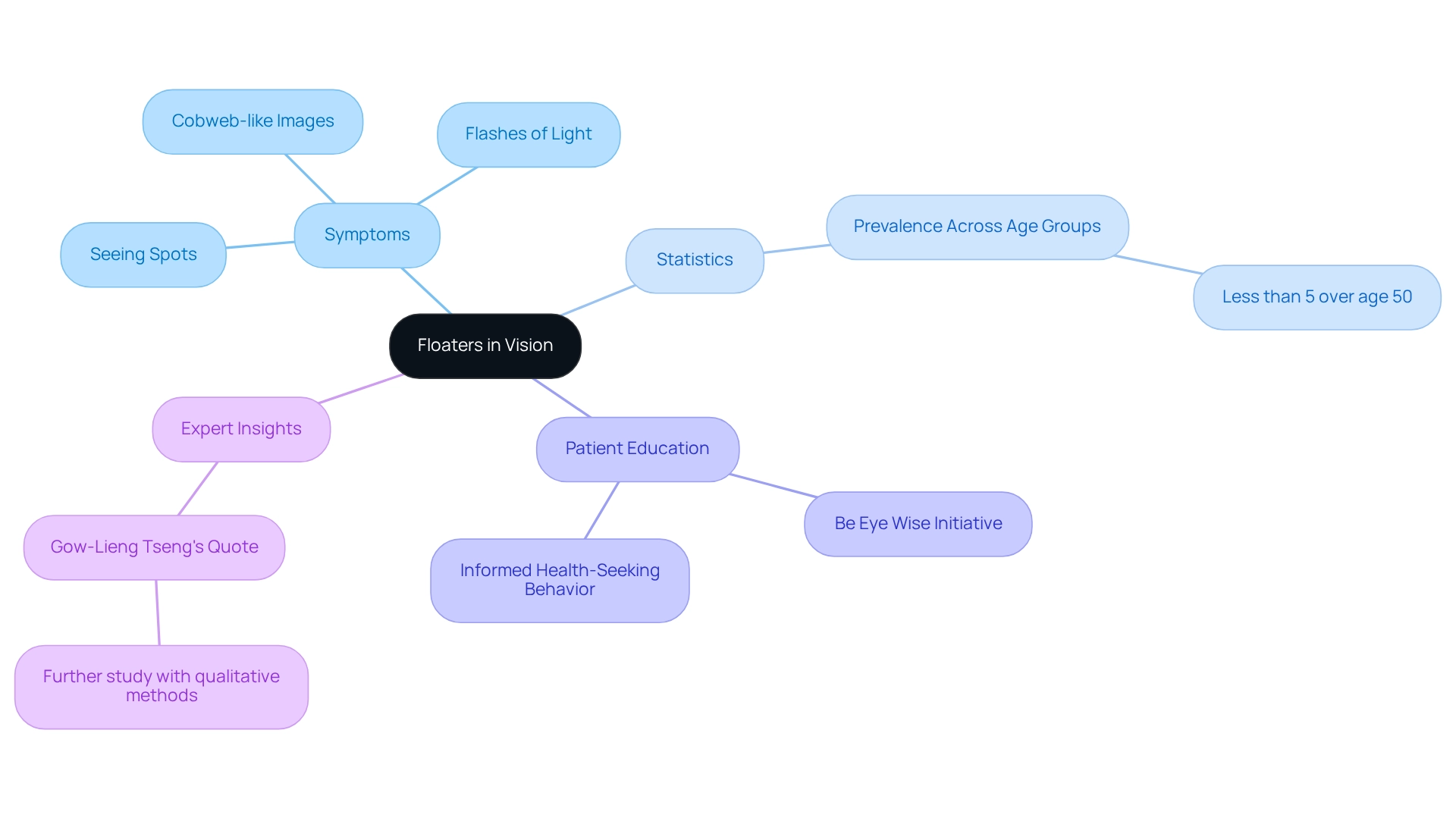
Vitreous Changes: The Primary Cause of Eye Floaters
primarily occur due to changes in the vitreous humor, the gel-like substance that fills the eye. As we age, the vitreous undergoes significant transformations, becoming more liquid and often shrinking. It’s common to feel concerned about these changes, as they can create floaters in the eye, which are clumps or strands within the vitreous that cast shadows on the retina and are perceived as moving spots. While this phenomenon is typically harmless, can help ease worries for many individuals.
Research indicates that roughly 70% of people over the age of 70 encounter . This highlights in the eye are among older adults. Additionally, studies show that preoperative contrast sensitivity is often significantly impaired in individuals with symptomatic visual disturbances, but this usually returns to normal following . We understand that this can be a source of anxiety, but knowing that there are available can provide reassurance.
During certain procedures, the vitreous may be replaced with solutions such as air, gas, silicone oil, or a balanced saline solution. Ongoing discussions among ophthalmologists emphasize the need for further research into , including office-based laser solutions for managing vitreous opacities. Dr. Groat notes that “the procedure takes only 20-60 minutes,” which offers a practical perspective on surgical interventions.
Comprehending these changes can help ease concerns, especially for those with . It’s important to remember that . We are here to help you through this process and ensure you feel supported every step of the way.
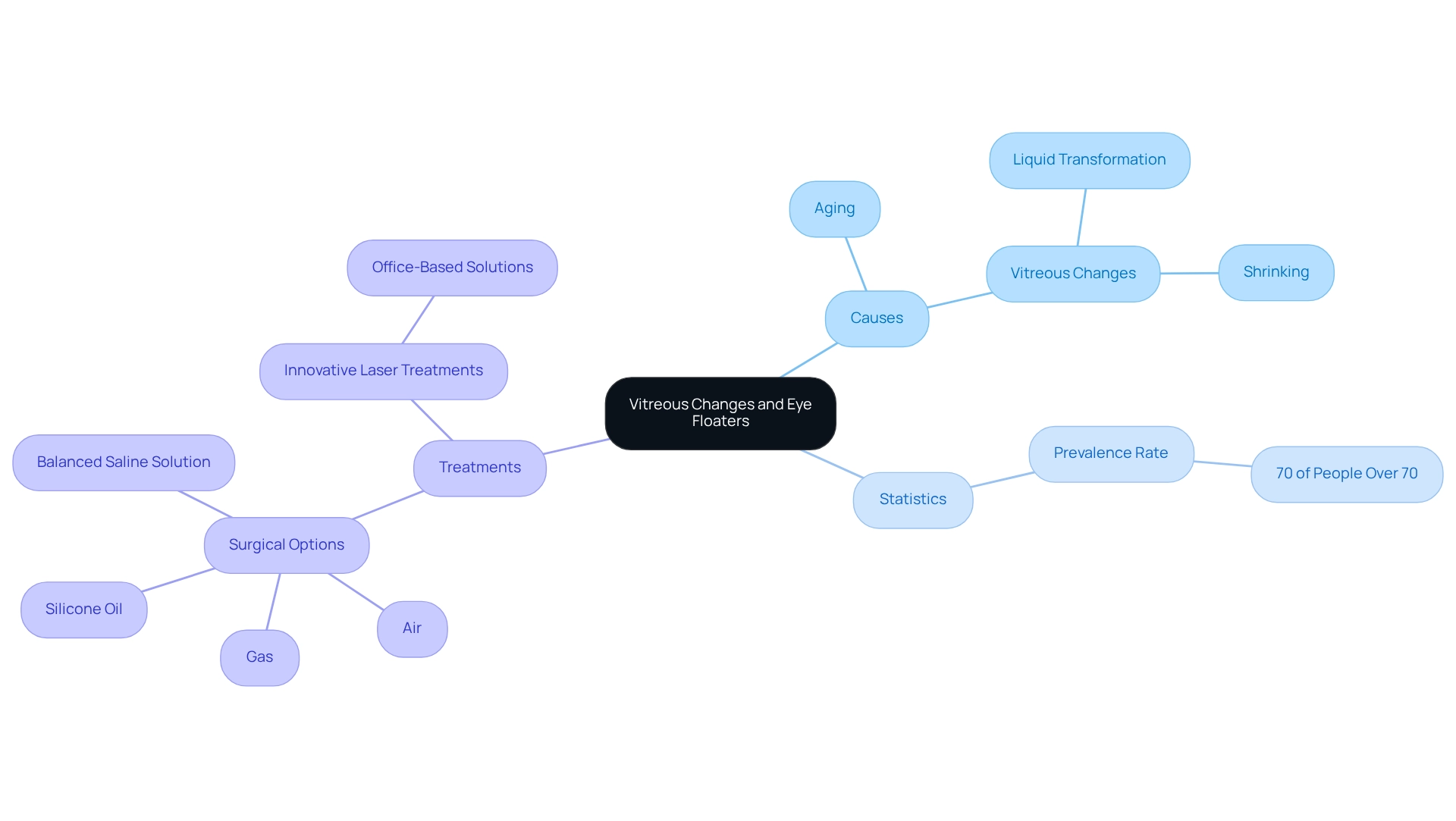
Aging Process: How It Contributes to Floaters
The aging process significantly influences the development of eye spots. As we age, the vitreous humor—a gel-like substance in the eye—undergoes changes in consistency and structure. This transformation can lead to , referred to as , which appear as small specks or strands drifting through our field of vision. Research indicates that around 75% of individuals over the age of 65 experience these disturbances, highlighting their prevalence among seniors. While generally harmless, floaters in eye can be by an eye care specialist. A study titled ‘Global Reach of the Survey’ examined various countries, including the United States, Australia, Israel, and the United Kingdom. It found that the occurrence of visual disturbances did not significantly differ among these groups, underscoring the shared experience of older individuals. Additionally, the incidence of (PVD)—a condition often associated with visual disturbances, such as floaters in eye—rises notably with age, increasing from 24% in those aged 50-59 to a concerning 87% in individuals aged 80-89.
Geriatric eye specialists emphasize the as part of the aging journey. They note that while floaters in eye can be irritating, they are typically harmless. However, it’s in floaters in eye or changes in vision, and we encourage consulting an to rule out more serious conditions. As awareness of the aging process and its effects on eye health grows, we urge patients to stay informed and proactive about their eye care.
Current research into the causes and treatments for vitreous anomalies highlights the need for . Patients should also be aware that for visual disturbances, and financing options like CareCredit are available to help manage expenses. This information can provide practical support for those exploring .
Eye Injuries: A Significant Cause of Floaters
Eye injuries can be distressing, often leading to such as , which may appear as small specks or strands in your field of vision. When trauma occurs, it can result in bleeding within the vitreous gel or trigger a condition known as posterior vitreous detachment (PVD). In PVD, the vitreous separates from the retina, which can lead to . If you have a , we understand how concerning it can be to notice new spots or floaters in the eye, as well as changes in your eyesight. It’s important to seek advice from your eye care specialist promptly.
Experiencing floaters in the eye after an eye injury is significant, and we want you to know that is crucial. For instance, , which may occur due to injury, often presents symptoms like flashes of light, spots, and visual field defects. We encourage you to seek a referral to an ophthalmologist as soon as possible to prevent any permanent vision loss. Superficial eyelid lacerations can typically be repaired within 12 to 36 hours for the best outcomes, highlighting the urgency of getting medical attention after an eye injury.
Experts stress the importance of , as many individuals may not fully appreciate the risks associated with eye injuries. As one expert noted, “Many workers consider eye protection unnecessary and choose not to wear their required eye protection.” Statistics indicate that while visual disturbances can frequently occur, the appearance of floaters in the eye after trauma requires careful observation and expert assessment. Real-life experiences show that even minor injuries can lead to significant visual disturbances, emphasizing the need for awareness and prompt action in response to any changes in your vision. With over 50 years of experience, Northwest Eye is here to provide comprehensive , ensuring you receive the necessary attention and support following .
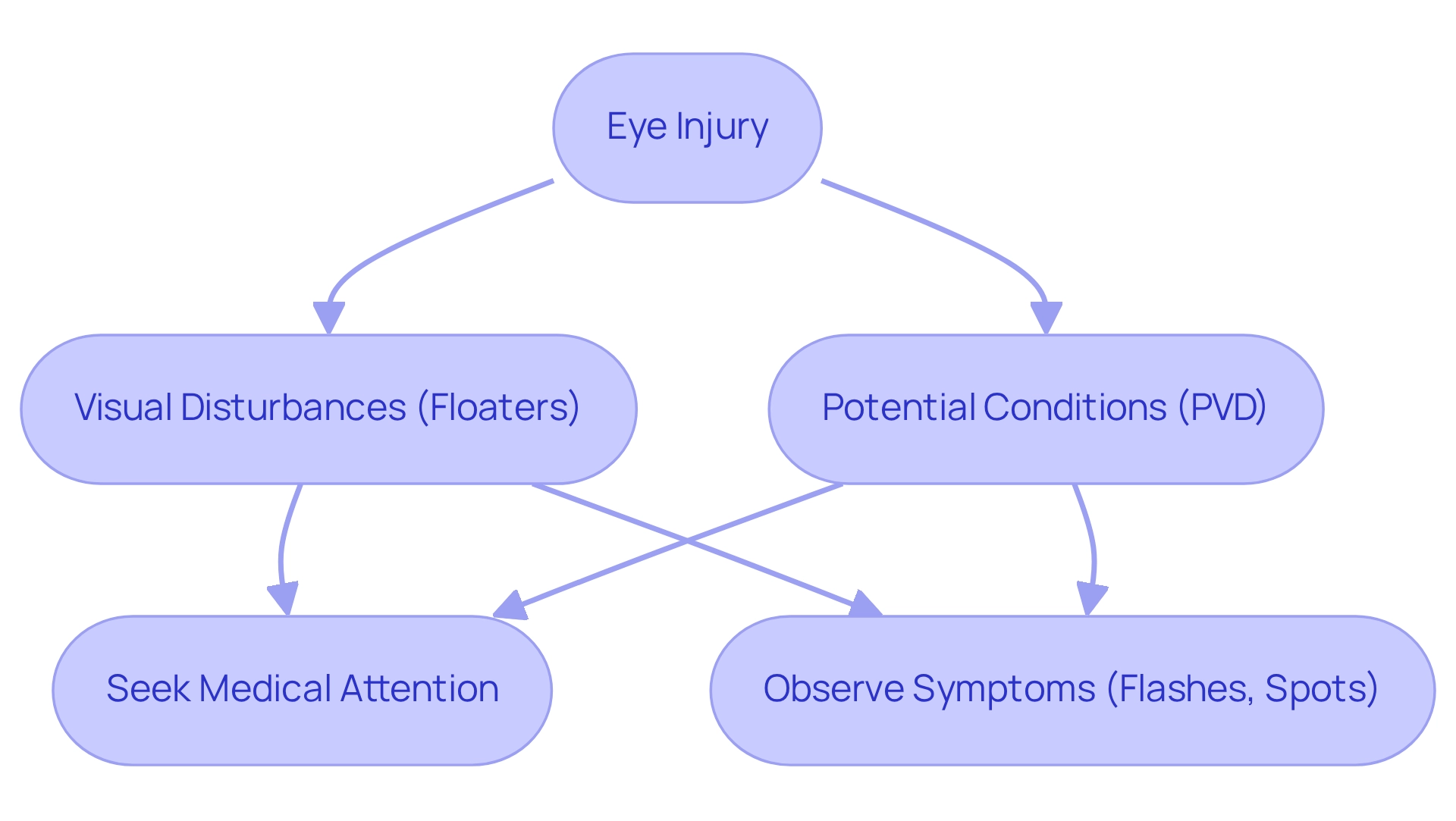
Eye Diseases: Linking Conditions to Floaters
Different eye conditions can significantly impact your vision, often leading to that may cause concern. Conditions such as , retinal tears, and uveitis can alter the vitreous gel within the eye, resulting in these disturbances. Diabetic retinopathy is particularly noteworthy, affecting around 8 million people in the United States. It can lead to changes in retinal structure that cause visual disturbances, which can be distressing.
We understand that the health of your eyes is crucial, and it’s important to know that , which help maintain retinal integrity, are also affected in diabetic retinopathy. This can lead to fluid accumulation and dysfunction, potentially worsening the presence of floaters. are essential for individuals with these conditions, as they allow for ongoing monitoring of eye health and timely intervention for any emerging symptoms.
A case study on shows that . However, many patients may require . It’s common to feel overwhelmed by these medical terms, but rest assured, retinal specialists emphasize that can significantly reduce the risk of complications, including worsening visual disturbances.
Therefore, maintaining a proactive approach to eye care is vital for those at risk. Remember, we are here to help you through this process and support you in every step of your .
Migraines: An Overlooked Cause of Floaters
Migraines are often overlooked as a cause of visual spots, and we understand that many individuals may experience , including spots, as part of . These can appear suddenly and may be accompanied by additional signs such as flashes of light. Research shows that the is significant, affecting their overall experience of the condition. It’s important to note that the highest incidence rate of migraine occurs in the age group of 10–14 years, highlighting the impact of migraines on younger individuals.
We encourage you to address any visual alterations with your , as these . Recent studies have indicated that among those experiencing migraines, with a notable occurrence of visual aura. This connection underscores the need for awareness and understanding. By as a possible indication of , you can more effectively manage your condition and seek appropriate medical guidance.
Moreover, a case study titled ” and PM” indicates that the presence of visual aura can greatly influence the clinical characteristics of migraines, emphasizing the importance of identifying these signs. Overall, recognizing visual disturbances as a symptom of migraine aura is crucial for effective management and timely intervention. We are here to help you through this process.
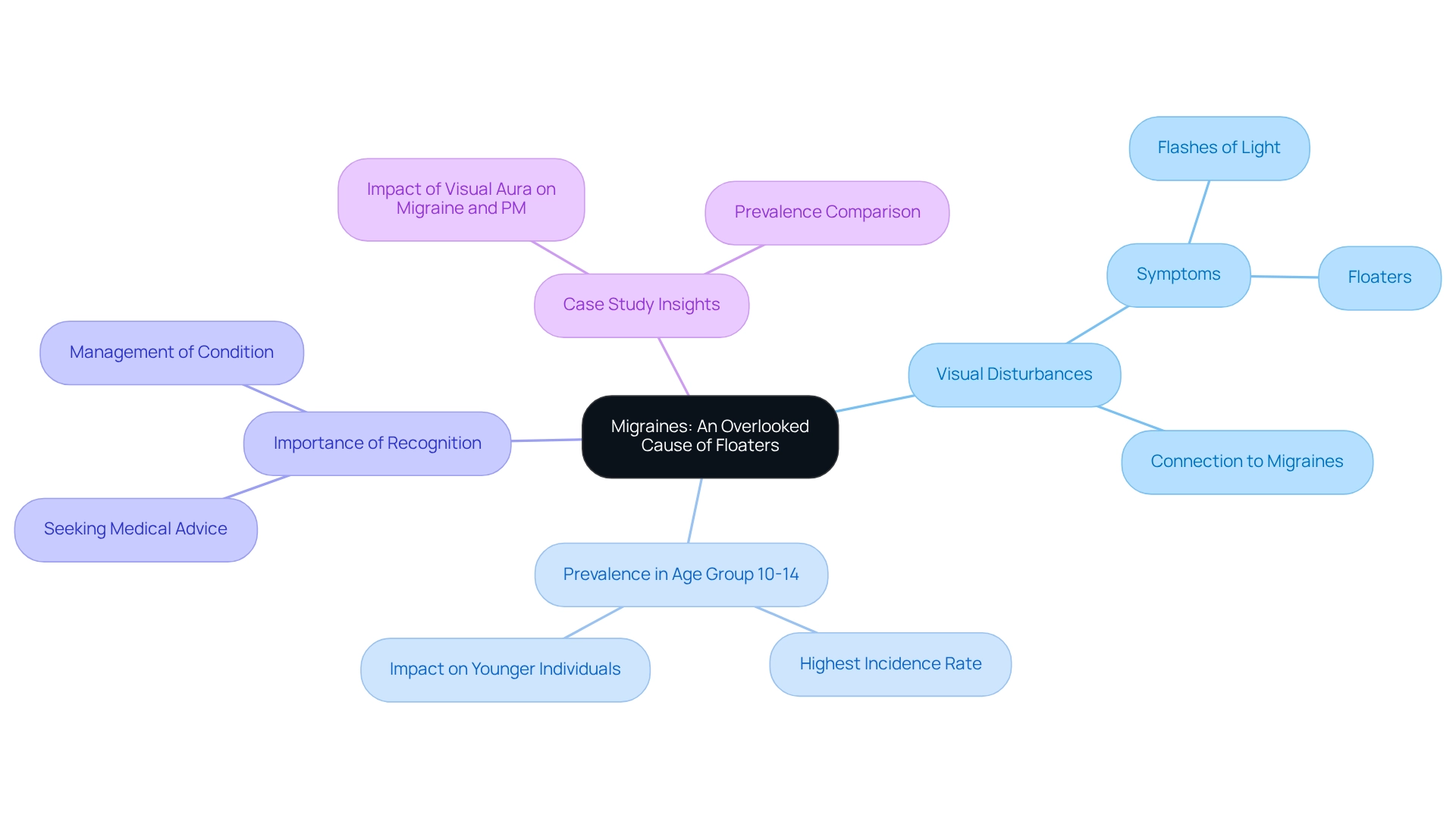
High Myopia: Understanding Its Role in Floaters
Severe myopia, characterized by intense nearsightedness, can understandably cause concern due to its association with . We recognize that the elongated shape of the eye in myopic individuals may lead to changes in the vitreous gel, which can result in . Recent studies show that those with are at a greater risk for such issues, which can sometimes precede more serious conditions like .
As of 2021, it’s important to note that 41 states in the US require vision screening for school children. This highlights the , allowing for timely intervention. Brien Holden, a respected leader in this field, emphasizes that high myopia poses that demands our urgent attention.
For patients with high myopia, are essential to monitor for any potential complications. We understand that a can be alarming, and it may indicate the need for prompt medical care. This underscores the importance of in managing the risks associated with high myopia.
Additionally, we are hopeful that will enhance our understanding of eye disorders, guiding us toward improved treatment strategies. This progress is vital in addressing the challenges posed by high myopia and its related visual disturbances. Remember, we are here to help you through this process, ensuring that you receive the support and care you need.
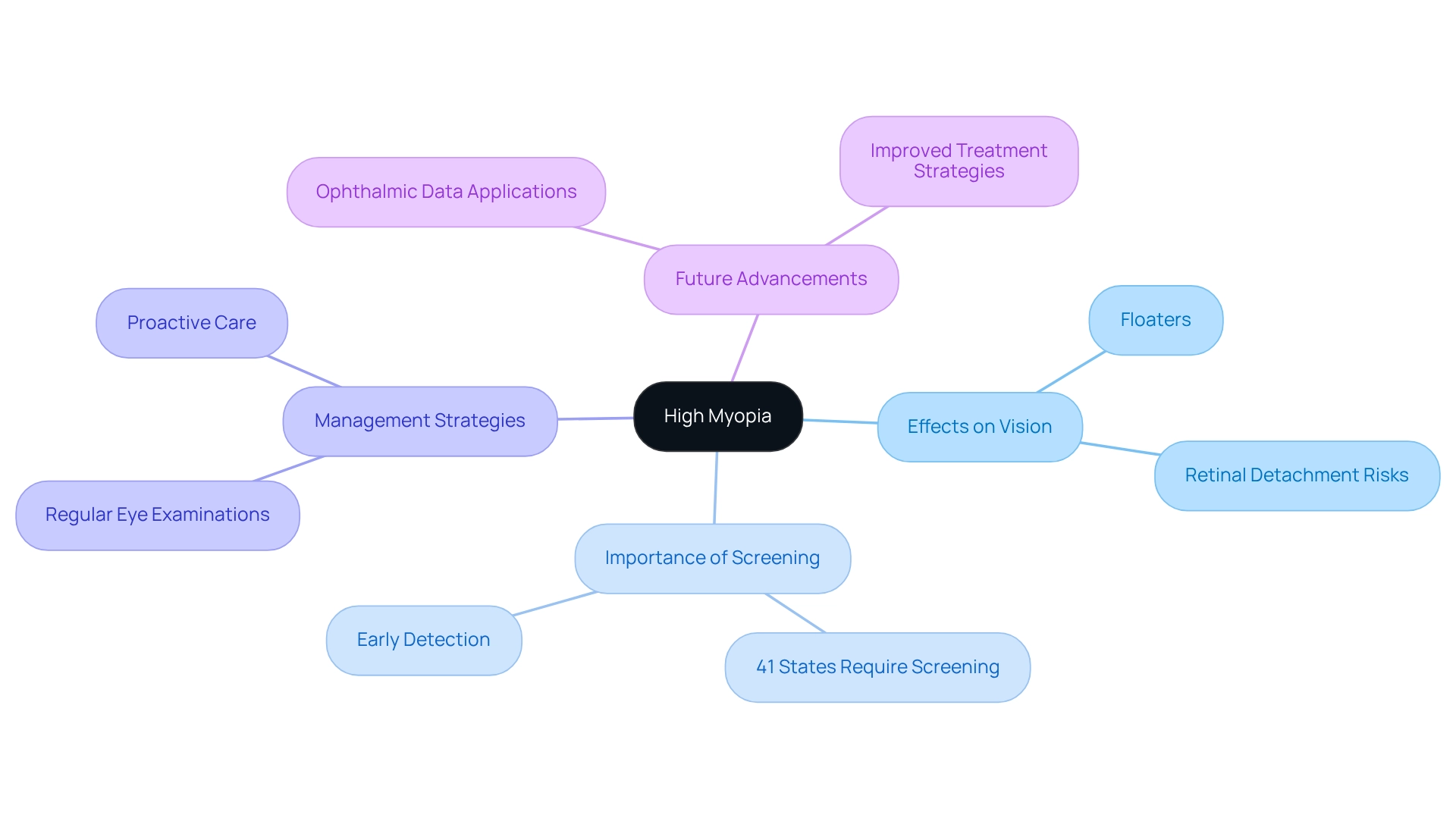
Inflammation: A Contributing Factor to Floaters
Inflammation in the eye, particularly from conditions like uveitis, can significantly impact your vision. When inflammatory cells invade the vitreous humor, they may disrupt normal sight, leading to sensations of . We understand that experiencing such changes can be concerning. Recent studies indicate that uveitis can cause a range of , with symptoms varying greatly among individuals, especially in children.
For instance, a case study titled ” highlights nonspecific symptoms like and , demonstrating how symptoms can vary from person to person. Additionally, blurred vision can also stem from other issues, such as nearsightedness, farsightedness, or astigmatism, which can often be corrected with lenses.
Blurred vision might also signal like cataracts, diabetic retinopathy, or , which are particularly important for those with cataracts. Statistics reveal that 8.3% of HTLV-1 patients experienced macular edema and epiretinal membrane, underscoring the prevalence of visual disturbances linked to inflammatory conditions.
If you notice spots in your vision along with symptoms like redness, discomfort, or light sensitivity, it’s common to feel anxious. We urge you to seek immediate medical assessment, as prompt action can address the and prevent further complications. Understanding the connection between inflammation and visual disturbances, along with the potential for blurred sight, is essential for managing and treating these concerns effectively.
It’s also important to remember that and may affect the other eye, emphasizing the need for ongoing monitoring of your eye health. We are here to help you through this process and support your journey towards better vision.
Medications: Recognizing Floaters as a Side Effect
Certain medications can lead to , and we understand that this can be concerning. Antidepressants, in particular, have been linked to such issues, including the appearance of spots in vision. Studies indicate that many individuals taking these medications report experiencing these disturbances. For example, , may cause serious eye problems, including damage to the optic nerve and retina, which can manifest as .
It’s important to recognize that can signal various , including floaters in the eye, such as:
- Diabetic retinopathy
- Macular degeneration
This is especially crucial for those with cataracts. Doctors who manage conditions with these medications will discuss with their patients to ensure they are informed and supported.
Pharmacists also emphasize the importance of discussing potential side effects with patients. They advise reading medication labels carefully and consulting an eye doctor if any vision changes occur. For patients on hydroxychloroquine, yearly are recommended to catch any potential damage early.
Regular eye exams are vital for those on long-term medications, as early detection can significantly improve outcomes. We encourage patients to actively engage with their healthcare providers to evaluate whether their medications might be contributing to their symptoms. This proactive approach is essential for maintaining and ensuring comprehensive care.
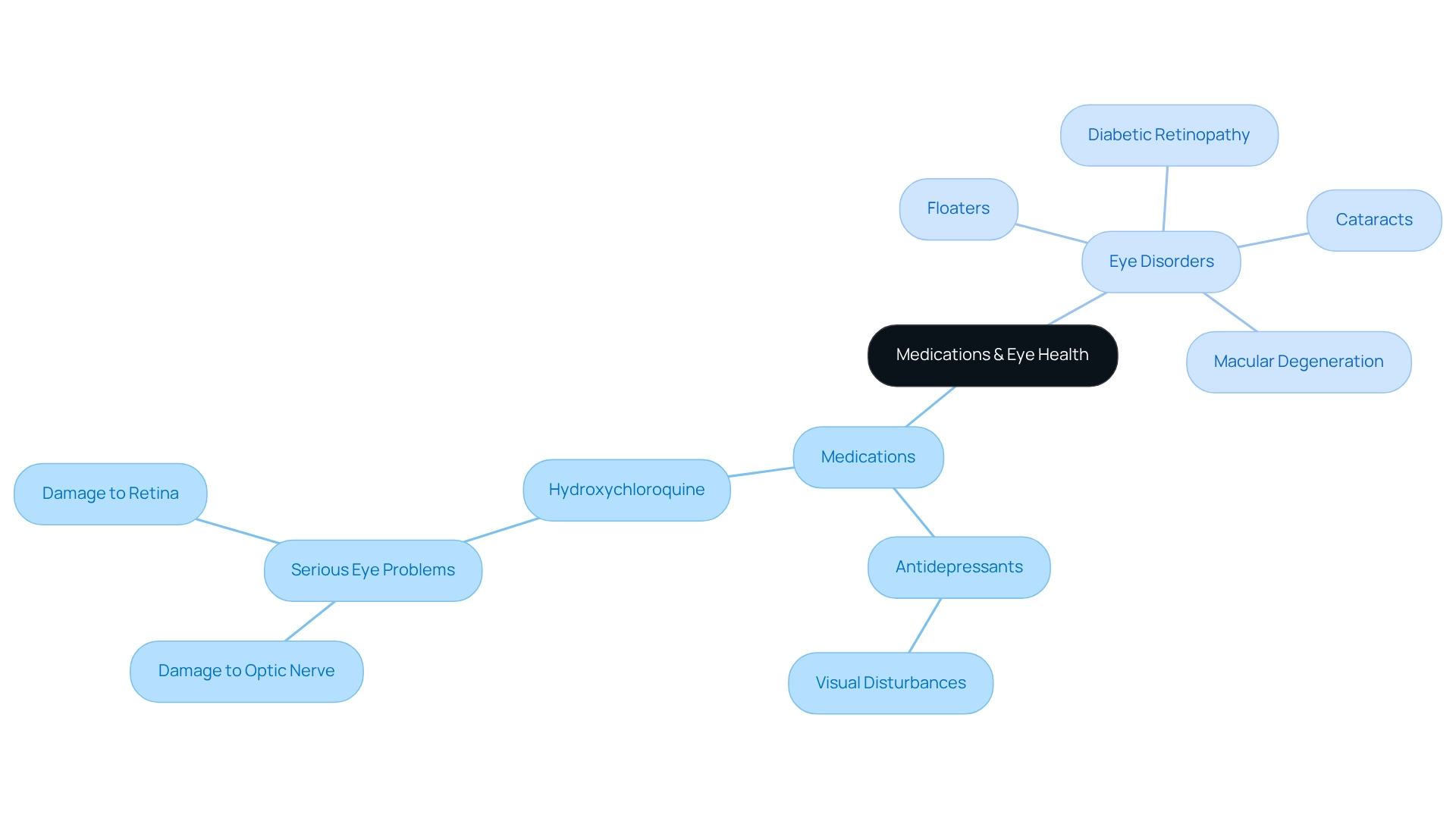
Regular Eye Exams: Key to Managing Floaters
Routine eye examinations are essential for addressing and maintaining overall . At Northwest Eye, our doctors and eye care specialists prioritize not just treatment but also your education, ensuring you understand your eye health and the factors that impact it. These examinations allow our specialists to thoroughly assess the vitreous and retina, observe any changes, and offer personalized advice on effectively managing visual disturbances, as we understand that it’s especially important for individuals to schedule , particularly if you notice an increase in floaters in the eye or other visual disruptions. Prompt intervention can significantly improve outcomes, as highlighted by case studies that stress the regarding treatments like vitrectomy. Dr. Pollack has observed that establishing these expectations leads to greater satisfaction, as it ensures you are well-informed about potential outcomes.
Furthermore, recent recommendations emphasize the need for based on your symptoms and preferences, reinforcing the importance of regular check-ups. A recent campaign has generated an estimated $700+ million boost in spending on vision care services, showcasing a strong financial commitment to maintaining eye health.
Statistics indicate that many individuals who do not undergo may face a higher occurrence of visual disturbances, underscoring the necessity for ongoing observation. By prioritizing annual eye exams, you can take proactive steps toward preserving your vision and addressing any emerging concerns related to floaters in the eye. As Dr. Melody Huang emphasizes, educating individuals on leading healthier lives is crucial, and are a key component of that education, which helps in , aligning with our Be Eye Wise initiative. To explore your options further, consider taking our or scheduling an appointment with our team today.
Hear from our pleased individuals:
- “Great place. The doctors and staff were extremely patient with our very active 15-month-old daughter.” – Lydea L.
- “All of the staff at Northwest Eye are friendly and get your needs taken care of in the best of ways.” – Perry H.
Conclusion
Understanding eye floaters is crucial for maintaining optimal eye health. We recognize that floaters can arise from various causes, such as aging, eye injuries, and underlying diseases. While often benign, floaters can significantly impact your quality of life, leading to feelings of anxiety and distraction. Regular eye examinations serve as a vital tool for monitoring these visual disturbances and addressing any emerging concerns.
The multifaceted nature of floaters, including their association with conditions like diabetic retinopathy, migraines, and high myopia, highlights the importance of patient education and proactive eye care. We understand that staying informed about the causes and implications of floaters empowers you to take necessary steps to protect your vision and seek timely medical advice when needed.
Ultimately, prioritizing your eye health through regular check-ups and education enables you to manage floaters effectively. As awareness grows, so does the understanding that timely intervention and informed decision-making can lead to better outcomes and an improved quality of life for those affected by floaters. We are here to help you through this process, ensuring you feel supported every step of the way.
Frequently Asked Questions
What are floaters in the eye?
Floaters are small specks or threads that drift across your field of vision, often caused by changes in the vitreous humor, the gel-like substance filling the eye.
Are floaters harmful?
Floaters are generally considered harmless, but they can significantly impact your quality of life and may cause feelings of anxiety or distraction.
What are the common signs of visual disturbances?
Common signs include seeing spots, flashes of light, and cobweb-like images in your sight.
Who is affected by visual disturbances?
Visual disturbances can affect individuals across various age groups, with a notable prevalence among older adults. Approximately 70% of people over the age of 70 experience these disturbances.
What causes floaters in the eye?
Floaters primarily occur due to changes in the vitreous humor, which can become more liquid and shrink as we age, leading to clumps or strands that cast shadows on the retina.
How can education help with concerns about floaters?
Education about visual disturbances can empower individuals to make informed choices about their eye care and reduce unnecessary consultations.
What should I do if I experience signs of visual disturbances?
If you experience signs associated with visual disturbances, it is advisable to schedule an appointment with a physician at Northwest Eye for a professional evaluation.
Are there treatment options for floaters?
Yes, treatment options exist, including surgical procedures where the vitreous may be replaced with solutions such as air, gas, or silicone oil. Ongoing research is also exploring innovative treatments.
What should I be aware of regarding the aging process and eye health?
As we age, changes in the vitreous humor can lead to visual disturbances like floaters. It’s important to stay informed and consult an eye care professional if there is a sudden increase in floaters or changes in vision.
Does health insurance cover treatment for visual disturbances?
Some treatment costs for visual disturbances may be covered by health insurance, and financing options like CareCredit are available to help manage expenses.






